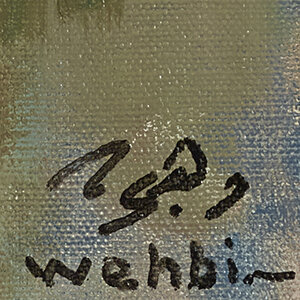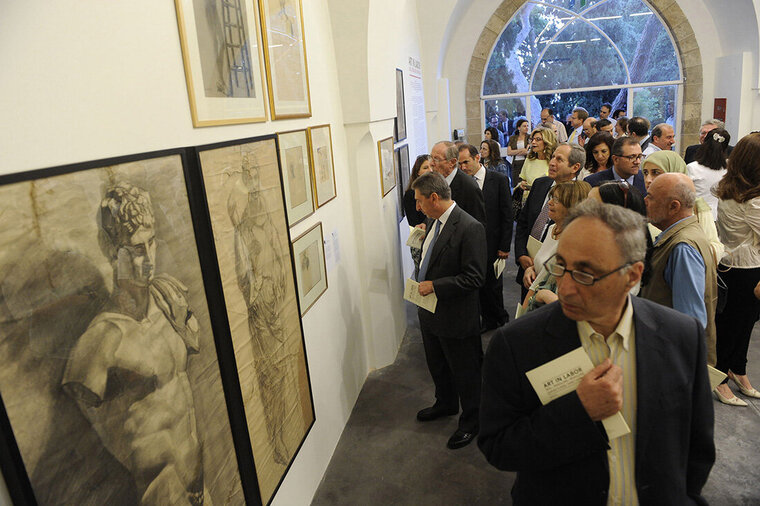


Last updated on Mon 20 May, 2013


Art in Labor: Skill, Deskilling, Reskilling
May 20 - July 27, 2013
AUB Byblos Bank Art Gallery
Artists: Georges Daoud Corm, Saliba Douaihy, John Carswell, Ghassan El Hajj, Khalid Hamza, Haitham Hassan, Lawrence Abu Hamdan, Mahmoud Khaled, Mohammad El Rawas, Gregory Sholette, Hito Steyerl, Rachid Wehbi, Vera Yeramian.
This exhibition examines the complex relation between art and labor. Its purpose is not to honor or celebrate labor as one of the activities essential to the human condition—the socialist realists have done this very well in the past. Instead, we look at art itself as a form of production, inquiring what kinds of labor enter into its making—its birth.
In the past, things appeared to be more simple. Artists were individuals who possessed certain manual skills which they acquired in the feudal system of guilds, later in the écoles and académies des beaux-arts, and—not long ago—in the Soviet schools of art and the unions of artists. One was not simply an artist but first and foremost a fine artist, that is a painter or a sculptor whose status and recognition was first to be won within a given métier on the basis of his or her manual skills. In the age of the Fine Arts, artistic skill was closely guarded and distributed by religious, national, or imperial institutions—a situation that remained for the most part unchallenged well into the twentieth century.
When in the early twentieth century the artistic avant-garde assaulted the very basis of the bourgeois institution of art—with its aesthetics, education, modes of production, reception and distribution—this also reflected within the domain of artistic labor. From Soviet Productivism and the Proletkult to Western European Dada and Cubism, from Vkhutemas to Bauhaus—all of these advocates of a new culture proposed radical ideas about artistic skill and the identity of the artist. These historical avant-garde gestures aimed for the most part at erasing certain well-guarded boundaries between art and life, artistic and empirical object, factory and artistic work, sacred and profane experience. Some of these radical ideas re-surfaced again after World War II under new conditions of capitalist production, when artists called for the dematerialization, de-aestheticization, and deterritorialization of the artistic object and artistic experience. In an emerging post-industrial, post-Fordist, post-modern, late capitalist society, the traditional artisanal skills of feudal or early industrial capitalism began to lose their prestige.
With the Art in Labor exhibition we would like to revisit and rethink this complex art historical process. The subtitle—Skill, Deskilling, Reskilling—is a quotation from a book by one of the participants in our events. Professor John Roberts has analyzed in detail the transformation of artistic labor within the context of the evolution of productive labor under capitalism. We borrow extensively from his labor theory of culture in order to comprehend a complex art historical trajectory of artistic labor.
The newly opened AUB Byblos Bank Art Gallery offers us the opportunity to set up a miniature art critical field, a mini-laboratory, that will allow us to better grasp the transformation of artistic labor over the past hundred years. This field lies at an art historical and aesthetic crossroads: between artistic tradition and innovation; artisanal manual skill and rational or conceptual form; expression (or mimetic behavior) and construction. Each artwork has been selected with the intention to reveal something about the dynamics of this field—in addition, of course, to testifying to its own laws of form. At the manual-artisanal and/or mimetic-expressive poles we exhibit a series of sketches and academic drawings made by artists of past generations, including such pioneers of Lebanese art as Georges Corm and SalibaDouaihy. Some of these drawings were made during their training at Western European fine arts academies during the first half of the last century. On walls next to and across these drawings we display works that operate within a more complex division of artistic labor; works that one might say are drawn towards the opposite pole where artistic labor has migrated after the erosion of the prestige of manual artistic skill. A video by Hito Steyerl and an installation by Gregory Sholette (who requested shared authorship with the workers of the physical plant at AUB who built his piece: Ghassan el Hajj, Khalid Hamza and Haitham Hassan) make succinct reference to the broader social context of productive labor under late capitalism. Lawrence Abu Hamdan and Mahmoud Khaled attest to the transformation of intellectual and rational processes into artistic form, evoking the ways in which economic and political factors today inform the identity of the artist. Mohammad El Rawas comes to remind us (albeit with some post-modernist detachment) that the historical transformation of artistic labor takes place within a complex dialectical field where conflicting extremes (expression and construction, or artisanal skill and conceptual formalization) are in a state of constant negotiation.
Join us in our endless discovery of modern and contemporary Arab art